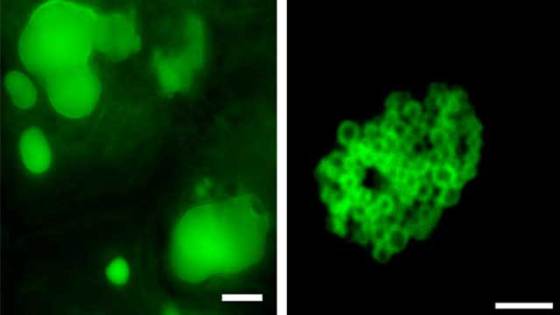Key genes for increasing oil content in plant leaves have been identified
 A group of researchers at the U.S. Department of Energy’s Brookhaven National Laboratory has identified the key genes involved in oil production and accumulation in plant leaves and vegetative plant tissues. Increased expression of these genes resulted in increased oil content in leaves – plant’s most abundant source of biomass. This finding could help increase the energy content of plant-based foods and renewable biofuel feedstocks.
A group of researchers at the U.S. Department of Energy’s Brookhaven National Laboratory has identified the key genes involved in oil production and accumulation in plant leaves and vegetative plant tissues. Increased expression of these genes resulted in increased oil content in leaves – plant’s most abundant source of biomass. This finding could help increase the energy content of plant-based foods and renewable biofuel feedstocks.
“Oil is twice as energy-dense as carbohydrates, which make up the bulk of leaves, stems, and other vegetative plant matter. If you want to cut calories from your diet, you cut fat and oils. Conversely, if you want to increase the caloric output of your biofuel or feed for livestock, you want more oil”, said Changcheng Xu, Brookhaven biochemist who led the research.
However, plants do not store much oil in their leaves and vegetative tissues. The greatest amount of oil is stored in plant seeds, where high-energy compounds provide food for development of plant embryos. Although oil isn’t stored in vegetative plant tissues, almost all plant cells have the capacity to make oil. Researchers wanted to find a way to reprogram plants cells to store oil in leaves and vegetative plants tissues, so they needed to identify the genes involved in this process.
The research team tested the effects of overexpressing or disabling genes that normally code for enzymes involved in oil production. Increasing the expression of the genes that normally boost oil production in seeds had no effect on oil production in leaves. Researchers found out that overexpressing one of those genes in leaves caused growth and developmental problems in the plants. However, altering the expression of a different oil-producing enzyme had dramatic effects on leaf oil production.
“If you knock out (disable) the gene for an enzyme known as phospholipid:diacylglycerol acyltransferase (PDAT), it doesn’t affect oil synthesis in seeds or cause any problems to plants, but it dramatically decreases oil production and accumulation in leaves. In contrast, overexpressing the gene for PDAT – that is, getting cells to make more of this enzyme – resulted in a 60-fold increase in leaf oil production”, said Xu.
The excess oil did not mix with cellular membrane lipids and was found in oil droplets within the leaf cells. These oil droplets are similar to those found in seeds, but much larger. According to the researchers, bigger droplets are a likely result of the fusion and can be easily broken down by other enzymes in the cells. On the other hand, oil droplets in seeds are coated with a protein oleosin, which prevents the droplets from fusing together, keeping them smaller while also protecting the oil inside.
The research team increased the expression of the gene for oleosin together with gene for PDAT which resulted in a 130-fold increase in production of leaf oil compared with control plants. This modification allowed the oil to be accumulated in large clusters of tiny oleosin-coated oil droplets. Studies showed that overexpressed gene for PDAT drastically increased the rate at which fatty acids were made.
Furthermore, plants that already have an elevated rate of fatty acid synthesis showed even more oil production in experiments with increased level of genes for oleosin and PDAT. The genetic boost resulted in oil production and accumulation of 170-fold compared with control plants, to the point where oil accounted for nearly 10 percent of the leaf’s dry weight.
“That potentially equals almost twice the oil yield, by weight that you can get from canola seeds, which right now is one of the highest oil-yielding crops used for food and biodiesel production. Burning plant biomass with such energy density to generate electricity would release 30 to 40 percent more energy, and the nutritional value of feed made from such energy-dense biomass would also be greatly enhanced”, said Xu.
According to the research team at the Brookhaven National Laboratory, more research needs to be done on feed crops. Also, there are challenges in finding ways to extract oil from leaves to convert it into biofuels. Nevertheless, unraveling the key genes for increasing oil content is a very promising path to improve the use of plants as a source for renewable energy production and feedstock.
For more information, read the papers published in the journals Plant Cell and The Plant Journal respectively: “Dual Role for Phospholipid: Diacylglycerol Acyltransferase: Enhancing Fatty Acid Synthesis and Diverting Fatty Acids from Membrane Lipids to Triacylglycerol in Arabidopsis Leaves” and “Phospholipid: diacylglycerol acyltransferase-mediated triacylglycerol biosynthesis is crucial for protection against fatty acid-induced cell death in growing tissues of Arabidopsis“.










Leave your response!